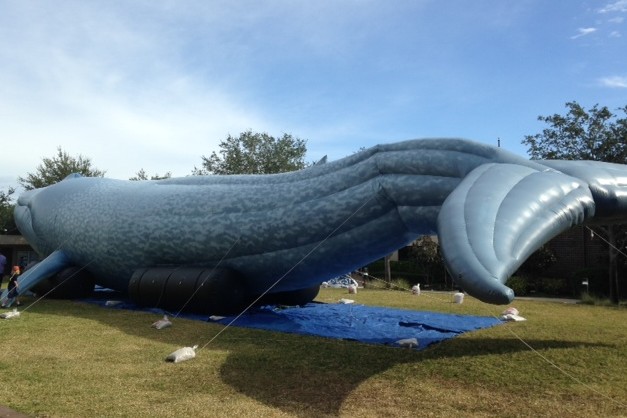A Whale of a Day
A life-size inflatable blue whale visits Berkeley
On Thursday, October 30, Berkeley had an enormous visitor. In fact, it was the largest living creature that’s ever lived—the blue whale. Although it was not alive, the creature’s dimensions were accurate. Stretching 85 feet long, Berkeley students were dwarfed by the enormity of such a spectacular creature. Even more important than the whale was the visitor that came to speak to students. Michael Fishbach, the founder of the Great Whale Conservancy, a nonprofit dedicated to conserving blue whales, gave spectacular talks about his work and the animals he saves. He spoke to each division during convocation, had a special luncheon for interested upper division students and taught many lower division students throughout the day. Fishbach has studied many species in order Cetacea and discussed his work with different species including bottlenose dolphins, common dolphins, pilot whales, orcas, fin whales, humpback whales, sperm whales and, of course, blue whales.
Fishbach has done work involving whales of all species. His favorite memory of an encounter was “saving the life of a whale that was entangled in a fishing net.” He is constantly “working to ensure the health of ecosystems” and care for the blue whales. Off the coast of California, ship channels pass directly through the most important feeding grounds for blue whales. Whales can be hit with boats, which can result in their death. Fishbach has talked to politicians about moving the ship channels so whales will not be impacted. He has already succeeded in moving some of them and will continue to work to protect fragile species.
Fishbach’s favorite part of his job is “field work,” which includes spending hours on the water looking for whales. He takes pictures of whale’s tail flukes (fins) and saves and catalogues them. These photos can later be used to identify the whale and are important to monitor populations. He has worked all over the world, but his favorite place is the Sea of Cortez by Baja California because it is beautiful, there are so many whales, and the water is so calm.
Although he enjoys field work, Fishbach said the most important part of his job is “educating children and the public” about these wonderful creatures. At the upper division luncheon, Fishbach discussed the impacts of whaling on the population of blue whales. Although whaling ended many years ago, the population of blue whales has not increased to what it was in pre-whaling times. Whales were hunted for their oil for fuel and energy, similar to how we use petroleum today. Over 95% of their populations were killed off, and the populations that do exist today are more separated, causing a decrease in genetic diversity.
The loss of these whales is a serious problem because whales provide necessary benefits to the entire world. Whale poop contains iron, which stimulates the growth of phytoplankton blooms. Phytoplankton, small photosynthetic creatures, live near the surface of the ocean and help remove carbon dioxide from the air. Because of this, they help to decrease the effects of global warming and produce a lot of the oxygen on Earth. Whales help the populations of phytoplankton to increase and therefore can help lessen global warming and reduce the harmful effects of climate change.

Nicole is a junior who loves Scuba diving and everything about the ocean. She loves nature photography, playing with her dog, and math and science. When...







